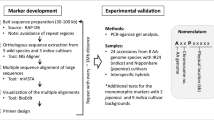Abstract
DNA polymorphisms from nucleotide insertion/deletions (InDels) in genomic sequences are the basis for developing InDel molecular markers. To validate the InDel primer pairs on the basis of the comparative genomic study on DNA sequences between an Indica rice 93-11 and a Japonica rice Nipponbare for identifying Indica and Japonica rice varieties and studying wild Oryza species, we studied 49 Indica, 43 Japonica, and 24 wild rice accessions collected from ten Asian countries using 45 InDel primer pairs. Results indicated that of the 45 InDel primer pairs, 41 can accurately identify Indica and Japonica rice varieties with a reliability of over 80%. The scatter plotting data of the principal component analysis (PCA) indicated that: (i) the InDel primer pairs can easily distinguish Indica from Japonica rice varieties, in addition to revealing their genetic differentiation; (ii) the AA-genome wild rice species showed a relatively close genetic relationship with the Indica rice varieties; and (iii) the non-AA genome wild rice species did not show evident differentiation into the Indica and Japonica types. It is concluded from the study that most of the InDel primer pairs obtained from DNA sequences of 93-11 and Nipponbare can be used for identifying Indica and Japonica rice varieties, and for studying genetic relationships of wild rice species, particularly in terms of the Indica-Japonica differentiation.
Similar content being viewed by others
References
Blair M W, Panaud O, McCouch S R (1999). Inter-simple sequence repeat (ISSR) amplification for analysis of microsatellite motif frequency and fingerprinting in rice (Oryza sativa L.). TAG, 98(5):780–782
Chang T T (1976). The origin, evolution, cultivation, dissemination and diversification of Asian and African rices. Euphytica, 25: 435–441
Chang T T (1984). Conservation of rice genetic resources: Luxury or necessity? Science, 224(4646): 251–256
Cheng K S, Wang X K, Lu Y X (1984). The synthetical research and utilization of Yunnan rice resource: 2. the recognization of the Asian cultivated rice classification. Acta Agronomica Sinica, 10(4): 271–279 (in Chinese)
Glaszmann J C (1987). Isozymes and classification of Asian rice varieties. Theoretical and Applied Genetics, 74: 21–30
Hilbe J M (2003). A review of current SPSS products: SPSS 12, Sigmaplot 8.02, SigmaStat 3.0, Part 1. American Statistician, 57(4): 310–315
Huang C P, Wu L M, Xiang Y (2003). Application of molecular marking technology in rice breeding. Acta Agriculturae Universitis Jiangxiensis, 25(3): 423–428 (in Chinese)
Jander G, Norris S R, Rounsley S D (2002). Arabidopsis map-based cloning in the post-genome era. Plant Physiology, 129: 440–450
Jiang J, Li J Q, Xu Z J (2003). The advancement of hybrid breeding between indica and japonica rices. Jilin Agricultural Sciences, 28(1): 9–14 (in Chinese)
Long W H, Xu M H (2002). RAPD-based genetic difference between indica rice and japonica rice. Journal of Yunnan Agricultural University, 17(3): 245–247 (in Chinese)
Lu B R, Zheng K L, Qian H R (2002). Genetic differentiation of wild relatives of rice as assessed by RFLP analysis. Theoretical and Applied Genetics, 106: 101–106
Morishima H, Oka H I (1981). Phylogenetic differentiation of cultivated rice. XXII. Numerable evaluation of the Indica-Japonica differentiation. Japanese Journal of Breeding, 31: 402–413
Murray M G, Thompson W F (1980). Rapid isolation of high molecular weight plant DNA. Nucleic Acids Research, 8: 4321–4325
Normile D (1997). Archaeology: Yangtze seen as earliest rice site. Science, 275(5298): 309–309
Petrie H (2002). Review of STATISTICA 6.0. British Journal of Mathematical and Statistical Psychology, 55: 391–392
Shen Y J, Jiang H, Jin J P (2004). Development of Genome-wide DNA polymorphism database for map-based cloning of rice genes. Plant Physiology, 135: 1198–1205
Song Z P, Xu X, Wang B (2003). Genetic diversity in the northernmost Oryza rufipogon populations estimated by SSR markers. TAG, 107: 1492–1499
Sun C Q, Wang X K, Yoshimura A (2002). Genetic differentiation for nuclear, mitochondrial and chloroplast genomes in common wild rice (Oryza rufipogon Griff.) and cultivated rice (Oryza sativa L.). TAG, 104(8): 1335–1345
Wang Z Y, Tanksley S D (1989). Restriction fragment length polymorphism in Oryza sativa L. Genome, 32: 1113–1118
Wang J, Yu J, Wang J (2003). Systematical research of rice genome based on the whole genome sequence. World Sci-tech R&D. 25(6): 35–41 (in Chinese)
Yu J, Hu S N, Wang J (2001). The complete sequence draft of Oryza sativa ssp. Indica. Chinese Science Bulletin, 46(23): 1937–1941 (in Chinese)
Zhang Q F, Maroof M A S, Lu T Y (1992). Genetic diversity and differentiation of indica and japonica rice detected by RFLP analysis. TAG, 83: 495–499
Zhu Z F, Xu M H (2002). Comparison of the genetic diversity of common wild rice and cultivated rice using SSR markers. Scientia Agricultura Sinica, 35(12): 1437–1441 (in Chinese)
Zhu M Y, Wang Y Y, Zhu Y Y (2004). Estimating genetic diversity of rice landraces from Yunnan by SSR assay and its implication for conservation. Acta Botanica Sinica, 46(12): 1458–1467
Zhuang J Y, Qian H R, Lin H X (1995). RFLP-based analysis of the origin and differentiation of Oryza sativa L. Chinese Journal of Rice Science, 9(3): 135–140 (in Chinese)
Author information
Authors and Affiliations
Corresponding author
Additional information
Translated from Journal of Fudan University (Natural Science), 2006, 45(3): 309–315 [译自: 复旦学报(自然科学版)]
Rights and permissions
About this article
Cite this article
Cai, X., Liu, J., Qiu, Y. et al. Differentiation of Indica-Japonica rice revealed by insertion/deletion (InDel) fragments obtained from the comparative genomic study of DNA sequences between 93-11 (Indica) and Nipponbare (Japonica). Front. Biol. China 2, 291–296 (2007). https://doi.org/10.1007/s11515-007-0042-2
Issue Date:
DOI: https://doi.org/10.1007/s11515-007-0042-2




